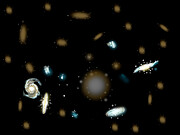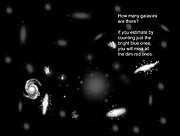Why Do Galaxies in the Young Universe Appear so Mature?
8 October 2004
Until now, astronomers have been nearly blind when looking back in time to survey an era when most stars in the Universe were expected to have formed. This critical cosmological blind-spot has been removed by a team using the Frederick C. Gillett Gemini North Telescope, showing that many galaxies in the young Universe are not behaving as expected some 8-11 billion years ago.
The surprise: these galaxies appear to be more fully formed and mature than expected at this early stage in the evolution of the Universe. This finding is similar to a teacher walking into a classroom expecting to greet a room full of unruly teenagers and finding well-groomed young adults.
"Theory tells us that this epoch should be dominated by little galaxies crashing together," said Dr. Roberto Abraham (University of Toronto) who is a Co-Principal Investigator of the team conducting the observations at Gemini. "We are seeing that a large fraction of the stars in the Universe are already in place when the Universe was quite young, which should not be the case. This glimpse back in time shows pretty clearly that we need to re-think what happened during this early epoch in galactic evolution. The theoreticians will definitely have something to gnaw on!"
The results were announced today at the 203rd meeting of the American Astronomical Society in Atlanta, Georgia. The data will soon be released to the entire astronomical community for further analysis, and three papers have been submitted for publication in Nature, The Astrophysical Journal, and The Astronomical Journal.
These observations are from a multinational investigation, called the Gemini Deep Deep Survey (GDDS), which used a special technique to capture the faintest galactic light ever dissected into the rainbow of colors called a spectrum. In all, spectra from over 300 galaxies were collected, most of which are within what is called the "Redshift Desert," a relatively unexplored period of the Universe seen by telescopes looking back to an era when the universe was only 3-6 billion years old. These spectra represent the most complete sample ever obtained of galaxies in the Redshift Desert. By obtaining large amounts of data from four widely separated fields, this survey provides the statistical basis for drawing conclusions that have been suspected by past observations done by the Hubble Space Telescope, Keck Observatory, Subaru Telescope and the Very Large Telescope over the past decade.
Studying the faint galaxies at this epoch when the Universe was only 20-40% of its current age presents a daunting challenge to astronomers, even when using the light-gathering capacity of a very large telescope like Gemini North with its 8-meter mirror. All previous galaxy surveys in this realm have focused on galaxies where intense star formation is occurring, which makes it easier to obtain spectra but produces a biased sample. The GDDS was able to select a more representative sample including those galaxies which hold the most stars–normal, dimmer, and more massive galaxies–that demand special techniques to coax a spectrum from their dim light.
"The Gemini data is the most comprehensive survey ever done covering the bulk of the galaxies that represent conditions in the early Universe. These are the massive galaxies that are actually more difficult to study because of their lack of energetic light from star formation. These highly developed galaxies, whose star-forming youth is in fact long gone, just shouldn't be there, but are," said Co-Principal Investigator Dr. Karl Glazebrook (Johns Hopkins University).
Astronomers trying to understand this issue might have to put everything on the table. "It is unclear if we need to tweak the existing models or develop a new one in order to understand this finding," said the survey's third Co-Principal Investigator, Dr. Patrick McCarthy (Observatories of the Carnegie Institution). "It is quite obvious from the Gemini spectra that these are indeed very mature galaxies, and we are not seeing the effects of obscuring dust. Obviously there are some major aspects about the early lives of galaxies that we just don't understand. It is even possible that black holes might have been much more ubiquitous than we thought in the early Universe and played a larger role in seeding early galaxy formation."
What is arguably the dominant galactic evolution theory postulates that the population of galaxies at this early stage should have been dominated by evolutionary building blocks. Aptly called the Hierarchical Model, it predicts that normal to large galaxies, like those studied in this work, would not yet exist and would instead be forming from local beehives of activity where big galaxies grew. The GDDS reveals that this might not be the case.
The spectra from this survey were also used to determine the pollution of the interstellar gas by heavy elements (called "metals") produced by stars. This is a key indicator of the history of stellar evolution in galaxies. Sandra Savaglio (Johns Hopkins University), who studied this aspect of the research said, "Our interpretation of the Universe is strongly affected by the way we observe it. Because the GDDS observed very faint galaxies, we could detect the interstellar gas even if partly obscured by the presence of dust. Studying the chemical composition of the interstellar gas, we discovered that the galaxies in our survey are more metal-rich than expected."
Caltech astronomer, Dr. Richard Ellis commented, "The Gemini Deep Deep Survey represents a very significant achievement, both technically and scientifically. The survey has provided a new and valuable census of galaxies during a key period in cosmic history, one that has been difficult to study until now, particularly for the quiescent component of the galaxy population."
Making observations in the Redshift Desert has frustrated modern astronomers for the last decade. While astronomers have known that plenty of galaxies must exist in the Redshift Desert, it is only a "desert" because we couldn't get good spectra from many of them. The problem lies in the fact that key spectroscopic features used to study these galaxies have been redshifted–due to the expansion of the Universe–into a part of the optical spectrum that corresponds to a faint, natural, obscuring glow in the Earth's nighttime atmosphere.
To overcome this problem, a sophisticated technique called "Nod and Shuffle" was used on the Gemini telescope. "The Nod and Shuffle technique enables us to skim off the faint natural glow of the night sky to reveal the tenuous spectra of galaxies beneath it. These galaxies are over 300 times fainter than this sky glow," explains Dr. Kathy Roth, an astronomer at Gemini who was also part of the team and obtained much of the data. "It has proven to be an extremely effective way to radically reduce the "noise" or contamination levels that are found in the signal from an electronic light detector."
Each observation lasted the equivalent of about 30 hours and produced nearly 100 spectra simultaneously. The entire project required over 120 total hours of telescope time. "This is a lot of valuable time on the sky, but when you consider that it has allowed us to help fill in a crucial 20% gap in our understanding of the Universe, it was time well spent," adds Dr. Glazebrook who developed the use of Nod and Shuffle with Joss Hawthorn for faint galaxy observations while at the Anglo-Australian Observatory a few years ago. A more complete history and explanation of the technique, including its original development in the mid 90's can be found on the Nod and Shuffle background page.
Previous studies in the Redshift Desert have concentrated on galaxies that were not necessarily representative of mainstream systems. For this study, galaxies were carefully selected based upon data from the Las Campanas Infrared Survey in order to assure that strong ultraviolet emitting starburst galaxies were not oversampled. "This study is unique in that we were able to study the red end of the spectrum, and this tells us about the ages of old stars," says Dr. Abraham. "We undertook incredibly long observations with Gemini–about ten times as long as typical exposures. This let us look at much fainter galaxies than is usually the case, and let us focus on the bulk of the stars, instead of just the flashy young ones. This makes it a lot easier for us to work out how the galaxies are evolving. We are no longer guessing at it by studying young objects and assuming the old objects were not contributing much to the story of galaxy evolution. It turns out that there are lots of old galaxies out there, but they're really hard to find."
The GDDS was supported by a grant from the Packard Foundation and institutional support from the United State's National Science Foundation, Canada's National Research Council and the Natural Sciences and Engineering Research Council of Canada, the United Kingdom's Particle Physics and Research Council and the GDDS team-member institutions consisting of:
Roberto G. Abraham & R. G. Carlberg Department of Astronomy & Astrophysics, University of Toronto, Canada
Karl Glazebrook & Sandra Savaglio Department of Physics & Astronomy, Johns Hopkins University, Baltimore, MD
Patrick J. McCarthy Observatories of the Carnegie Institution of Washington, Pasadena, CA
David Crampton & Richard Murowinski Herzberg Institute of Astrophysics, National Research Council, Victoria, British Columbia, Canada
Inger Jørgensen & Kathy Roth Gemini Observatory, Hilo, HI
Isobel M. Hook Department of Astrophysics, Nuclear & Astrophysics Laboratory, Oxford University, England
Hsiao-Wen Chen Center for Space Research, Massachusetts Institute of Technology, Cambridge, MA
Ronald O. Marzke Dept. of Physics and Astronomy, San Francisco State University, San Francisco, CA
Notes
The Gemini Multi-Object Spectrograph used on the Frederick C. Gillett Gemini Telescope on Mauna Kea to make the GDDS observations is one of two identical instruments, which are used on both Gemini telescopes. The GMOS instruments were built as a joint partnership between Gemini, the National Research Council of Canada's Herzberg Institute of Astrophysics, the UK Astronomy Technology Centre and Durham University, UK. Separately, the U.S. National Optical Astronomy Observatory provided the detector subsystem and related software. GMOS is primarily designed for spectroscopic studies where several hundred simultaneous spectra are required, such as when observing star and galaxy clusters. GMOS also has the ability to focus astronomical images on its array of over 28 million pixels.
Contacts
Peter Michaud
Gemini Observatory
Hilo HI, USA
Tel: (808) 974-2510
Cell: (808) 937-0845
Email: pmichaud@gemini.edu
Roberto Abraham
University of Toronto
Tel: 416/946-7289
Cell: 416/830-8172
Email: abraham@astro.utoronto.ca
About the Release
| Release No.: | gemini0406 |
| Facility: | Gemini North |
| Instruments: | GMOS-N |
| Science data: | 2004Natur.430..181G 2004ApJ...602...51S 2004AJ....127.2455A |








